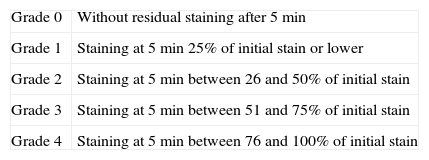To present our work with the Masterka self-adjusting monocanalicular intubation without nasal recuperation in congenital lacrimal obstruction in children over 12-months old.
MethodsA total of 40 children between the ages of one and seven (average age 2.6 years) were consecutively operated on.
The Masterka catheter has a flexible metal guide inside the silicone tube that covers it completely. The proximal end is fixed onto the lacrimal punctum by pushing it with a dilator or forceps. Its correct position was monitored and visually checked in real time during surgery in all cases.
ResultsThe average surgery time, excluding anesthetic, was 1.56min, ranging from 1.05 to 4min.
The final success was 97.5%, considering absence of epiphora, disappearance of coloring in lacrimal meniscus, and mucopurulent secretion.
The average follow-up time was 15 months (ranging from 7 to 21 months).
ConclusionsMasterka intubation is an effective primary treatment. It is no more difficult than a simple catheter, since the surgical technique is similar, but with better functional results. It avoids the possibility of having to repeat the catheterization and it is easier to carry out than bicanalicular intubation, since there is no need to manipulate repeatedly or use surgical instruments in the inferior meatus, thus simplifying the process.
Presentar nuestra experiencia con la intubación monocanalicular autoestable Masterka, sin recuperación nasal, en la obstrucción lagrimal congénita en niños mayores de un año.
MétodosUn total de 40 niños con edad media de 2,6 años (rango 1-7 años) fueron intervenidos de forma consecutiva.
La sonda de Masterka incluye una guía metálica flexible dentro del tubo de silicona que la cubre totalmente hasta su extremo distal. El extremo proximal se ancla a punto lagrimal tras presionarlo con el terminal de un dilatador o pinza.
Hubo monitorización y comprobación visual endoscópica de su correcta ubicación en tiempo real en todos los casos.
ResultadosEl tiempo medio de maniobras quirúrgicas, excluyendo el tiempo anestésico, fue 1,56 min (rango 1,05-4).
Los éxitos finales fueron un 97,5%, entendiéndolos como ausencia de epífora, la desaparición del colorante en menisco lagrimal y de secreción mucopurulenta. El tiempo medio de seguimiento fue 15 meses (rango 7-21).
ConclusionesLa intubación con Masterka es un tratamiento primario efectivo. No ofrece más dificultad que el sondaje simple, puesto que la técnica quirúrgica es similar, sin embargo sus resultados funcionales son mejores, evita la posibilidad de tener que repetir el sondaje y es más fácil de realizar que la intubación bicanalicular clásica, al no precisar manipulaciones repetidas ni tener que introducir instrumental quirúrgico en el meato inferior, simplificando el proceso.












